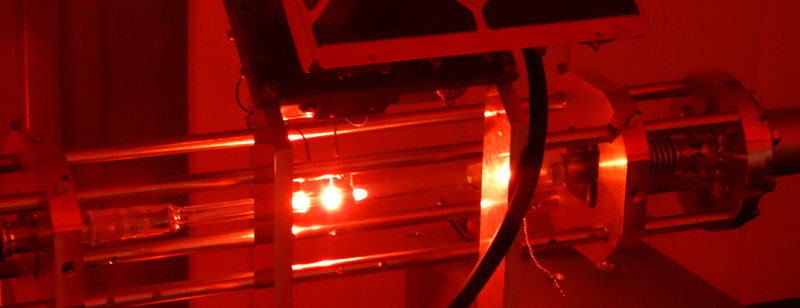
Abstract
He-Ne ring lasers are, actually, the most sensitive devices for inertial rotation measurements. Depending on their linear dimensions, they find applications in different fields: from inertial navigation to structural engineering, from metrology to geophysics and fundamental physics [1,2]. GINGER - Gyroscopes IN GEneral Relativity [3] - will be a triaxial ultra-sensitive ring laser gyroscope whose primary target is a ground measurement of the Lense-Thirring effect, a small shift of the Earth rotation rate foreseen by Einstein's General Relativity. This target implies a measurement of the Earth rotation rate with a sensitivity better than one part over 1010 and so requires a high level of stability and accuracy of the laser array and of the gyroscope configuration. The experiment requires an underground location so to reduce the detrimental effects induced by low frequency noises, such as wind load, top soil slow motion due to atmospheric pressure changes, and rain. LNGS insures, actually, a very good shielding against all kinds of surface noise. At the present stage, a square 3.6 m side gyroscope, hereafter indicated as GINGERino, has been installed south of node B far from the laboratory human activity. This preliminary instrument aims at measuring the very low frequency rotational motions inside LNGS, to show if it is a suitable location for realizing the far reaching goal of measuring the LT effect.
GINGERino
Measuring Lense-Thirring effect as a tiny variation of the Earth local rotation requires a sensitivity of the order of 10-14 rad/s. Inertial navigation systems, based on ring laser, usually have an area of <0.02 m2 and a sensitivity of about 5x10-7 rad/s. This performance level, fully sufficient for navigation purposes, falls short by several orders of magnitude for most scientific applications; even more for fundamental physics.
Actually, the best performing ring laser is the Gross Ring (G) in Wettzell a square ring, 4 m in side, mounted on an extremely rigid and thermally stable monolithic Zerodur slab. G has a lower boundary below 10-12 rad/s at 1000-s integration time. This sensitivity is above the requirement for the measurement of the GR effects, but various improvements in technologies, size of the ring, global design and signal filtering should fill the remaining gap.
A ring laser is a rotational sensor based on the Sagnac effect where two counter-propagating laser beams inside a closed path acquire a phase difference proportional to the (local) angular velocity projected along the enclosed surface vector. Its sensitivity, in turns, depends on the wavelength of the travelling light beams and the ratio between the area of the enclosed surface and the path length.
Several noise sources affect the actual instrument accuracy. In particular, laser dynamic and geometrical distortions have to be considered and under control for enhancing accuracy and improving the instrument duty-cycle. Moreover, an environment stable, in temperature, airflow, and humidity, is essential for the success of GINGER.
GINGERino, the GINGER single axis prototype installed inside LNGS, aim at reaching the sensitivity of G and, possibly, improve the integration time so to have enough accuracy to detect low frequency noise coming from the Earth micro seismic activity. The analysis of the LNGS residual noise is of critical importance for paving the way to the final design and installation of the GINGER array of gyrolasers.
GINGERino is a 3.6 m square ring laser installed at the end of 2014 near node B of LNGS. At the time of writing, the laser has been ignited and the first bare observation of the Sagnac signal has been obtained. The system is contained in an anechoic room aimed at shielding the apparatus from the not friendly outside temperature and relative humidity condition. The room is now fully operating and the inside temperature is kept around 18°C by passive IR heaters.
In the next future (see up-to-date status at https://web2.infn.it/GINGER/index.php/it/) the system will undergo to several technical improvement and, possibly, data taken is expected to start before summer 2015.
Spokesperson
This email address is being protected from spambots. You need JavaScript enabled to view it. (INFN Pisa)
Collaboration
GINGER is an INFN (CSN 2) experiment which brings together the sections of Pisa, Naples, LNL and Turin and that takes advantage of an ongoing collaboration with INGV (National Institute of Geophysics and Volcanology). Recently a group at the University of Padua (Department of Information Engineering) has joined the collaboration. Moreover, the experiment is in collaboration with U. Hugentobler and U.K. Schreiber of the Technical University of Munich (TUM - Germany), Heiner Igel of Ludwig Maximilians University Munich (LMU – Germany) and JP Wells of the University of Canterbury (Christchurch - New Zealand).
Recent publications
Beverini N, Allegrini M, Beghi A, Belfi J, Bouhadef B, Calamai M, Carelli G, Cuccato D, Di Virgilio A, Maccioni E, Ortolan A, Porzio A, Santagata R, Solimeno S, Tartaglia A, “Measuring general relativity effects in a terrestrial lab by means of laser gyroscopes”, LASER PHYSICS, 24-7, 074005 (2014).
Belfi J, Beverini N, Cuccato D, Di Virgilio A, Maccioni E, Ortolan A, Santagata R, “Interferometric length metrology for the dimensional control of ultra-stable ring laser gyroscopes”, CLASSICAL AND QUANTUM GRAVITY, 31-22, 225003 (2014).
Di Virgilio Angela, Allegrini Maria, Beghi Alessandro, Belfi Jacopo, Beverini Nicolo, Bosi Filippo, Bouhadef Bachir, Calamai Massimo, Carelli Giorgio, Cuccato Davide, Maccioni Enrico, Ortolan Antonello, Passeggio Giuseppe, Porzio Alberto, Ruggiero Matteo Luca, Santagata Rosa, Tartaglia Angelo, “A ring lasers array for fundamental physics”, COMPTES RENDUS PHYSIQUE, 15-10, (2014).
R. Santagata, A. Beghi, J. Belfi, N. Beverini, D. Cuccato, A. Di Virgilio, A. Ortolan, A. Porzio, S. Solimeno, “Optimization of the geometrical stability in square ring laser gyroscopes”, Class. Quantum Grav. 32:055013 (2015).
Official website



